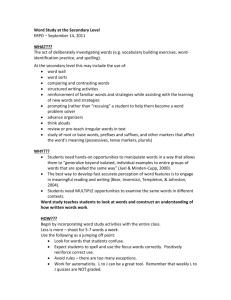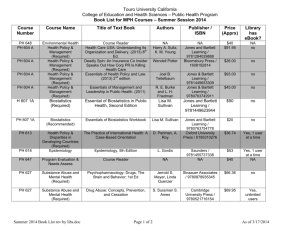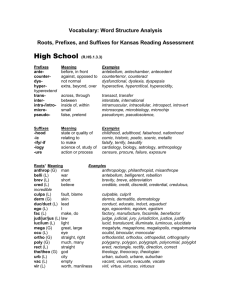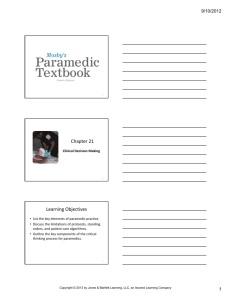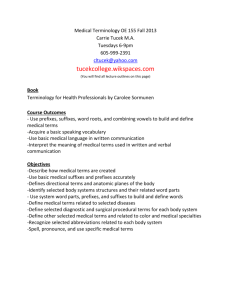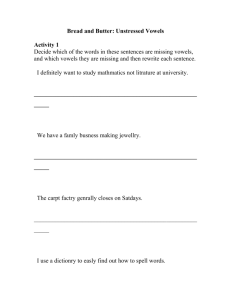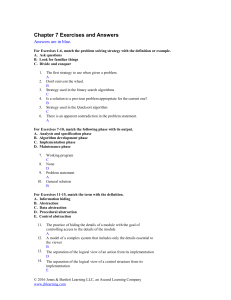Chapter 9 Learning Objectives
advertisement
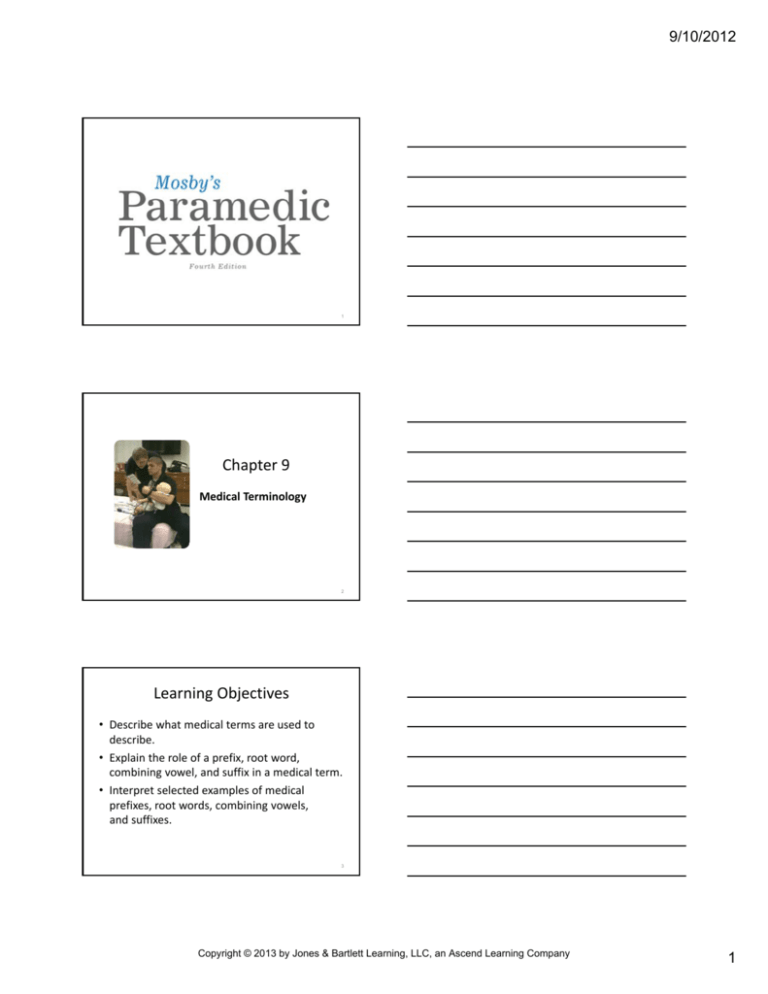
9/10/2012 1 Chapter 9 Medical Terminology 2 Learning Objectives • Describe what medical terms are used to describe. • Explain the role of a prefix, root word, combining vowel, and suffix in a medical term. • Interpret selected examples of medical prefixes, root words, combining vowels, and suffixes. 3 Copyright © 2013 by Jones & Bartlett Learning, LLC, an Ascend Learning Company 1 9/10/2012 Learning Objectives • Distinguish between singular and plural forms of medical terms. • Use accepted medical abbreviations appropriately. • Discriminate between similar medical terms and abbreviations. 4 The Language of Medicine • Oldest written sources, Hippocratic writings, 5th/4th centuries BC – Beginning of Greek era – Lasted after Roman conquest – Renaissance (14th to 17th centuries), Greek language not widely understood – Greek words translated into Latin – Most medical terms Greek derived, Latin root – Disease terms usually Greek origin – Anatomy terms usually Latin origin 5 Word Parts • Describe – Body structures, systems – Anatomical regions, locations – Diseases, other health problems – Medical, surgical procedures – Diagnostic tests – Medical instruments 6 Copyright © 2013 by Jones & Bartlett Learning, LLC, an Ascend Learning Company 2 9/10/2012 Word Parts • Broken down into one or more word parts – Prefixes – Suffixes – Root words – Some linking, combining vowels – Help in use, understanding 7 8 Word Parts • Prefixes – One or more root syllables – Beginning of word – Describes location, intensity • Example: abnormal – Prefix is ab = away from – Normal = within balance – Meaning = not within balance 9 Copyright © 2013 by Jones & Bartlett Learning, LLC, an Ascend Learning Company 3 9/10/2012 Word Parts • Suffixes – End of word – Describes condition, diagnosis • Example: bronchitis – Root word is bronchi – Suffix is itis = inflammation – Meaning = inflammation of bronchi 10 Word Parts • Root words – Combined to describe particular structure, condition – Derived from Latin, Greek nouns, verbs, adjectives • Example: cardiopulmonary – Root word is cardio = heart – Pulmonary = lungs – Meaning = cardiac and respiratory systems 11 Word Parts • Combining vowels – Linking vowels – Make terms easier to pronounce – Vowel most used: o • Example: Sternocleidomastiod = stern‐o‐cleid‐o‐ mastoid – Vowels i, a also used – Often used between root and suffixes, roots and other roots – Not used between prefixes and roots 12 Copyright © 2013 by Jones & Bartlett Learning, LLC, an Ascend Learning Company 4 9/10/2012 Making Medical Terms Plural • Majority of terms have Greek or Latin origin • Unusual rules for turning singular into plural form • If term ends in “a,” add “e” – Bursa = bursae 13 Making Medical Terms Plural • If term ends in “ex” or “ix,” change to “ices” – Appendix = appendices – Cervix = cervices • If term ends in “is,” change to “es” – Diagnosis = diagnoses • If term ends in “itis,” drop “s,” add “des” – Arthritis = arthritides 14 Making Medical Terms Plural • If term ends in “nx,” change the “x” to “g,” add “es” – Phalynx = phalanges • If term ends in “on,” change to “a” – Ganglion = ganglia • If term ends in “um,” change to “a” – Diverticulum = diverticula • If term ends in “us,” change to “i” – Alveolus = alveoli 15 Copyright © 2013 by Jones & Bartlett Learning, LLC, an Ascend Learning Company 5 9/10/2012 Abbreviations, Acronyms, Symbols • Useful for efficient communication, documentation – Thoroughness – Precision – Accuracy – Form of medical shorthand – Universally understood 16 Abbreviations, Acronyms, Symbols • Do not use list – May 2005, Joint Commission affirmed “do not use” list of abbreviations – Eliminates abbreviations, acronyms, symbols, drug dose designations that could be confusing, dangerous, or might result in errors – EMS agencies, health care facilities use list as documentation protocol – Updated annually 17 Pronouncing Medical Terms • Correct spelling, pronunciation necessary, expected • Consider how terms are built – Analyze, understand, memorize root words, prefixes, suffixes – Pronunciation varies, no rigid rules – Some terms acceptably pronounced more than one way – Example: angina (an’jin a), emphasis first syllable, short I, and angina (an jin’ a), emphasis second syllable, long i 18 Copyright © 2013 by Jones & Bartlett Learning, LLC, an Ascend Learning Company 6 9/10/2012 Pronouncing Medical Terms • Some medical terms look alike, sound alike, but have very different meanings • Pronunciation perfected by using term frequently, saying it aloud • If unsure, check medical dictionary 19 Summary • Medical terminology is language of medicine – Important to know it to communicate, interpret patient information with other health care personnel • Medical terms are used to describe body structures, systems, and functions; anatomical regions and locations; diseases and other health problems; medical and surgical procedures; diagnostic tests; and medical instruments 20 Summary • Medical terms are broken down into several parts, including prefixes, suffixes, root words, and some combining vowels • Prefix is root syllable at the beginning of a word that describes location or intensity • Suffix occurs at the end of a word and describes patient’s condition or diagnosis 21 Copyright © 2013 by Jones & Bartlett Learning, LLC, an Ascend Learning Company 7 9/10/2012 Summary • Root words describe structure or condition, may be combined with other root words, a prefix and/or a suffix • Combining vowels join syllables in medical terms to make pronunciation easier • Interpret medical terms by analyzing each word part, then combining them to determine the meaning 22 Summary • There are specific rules to convert medical terms from singular to plural • Medical abbreviations, acronyms, and symbols are forms of medical shorthand – Important to use abbreviations approved within your EMS system • Must pronounce medical terms correctly so intended meaning will be communicated clearly 23 Questions? 24 Copyright © 2013 by Jones & Bartlett Learning, LLC, an Ascend Learning Company 8

